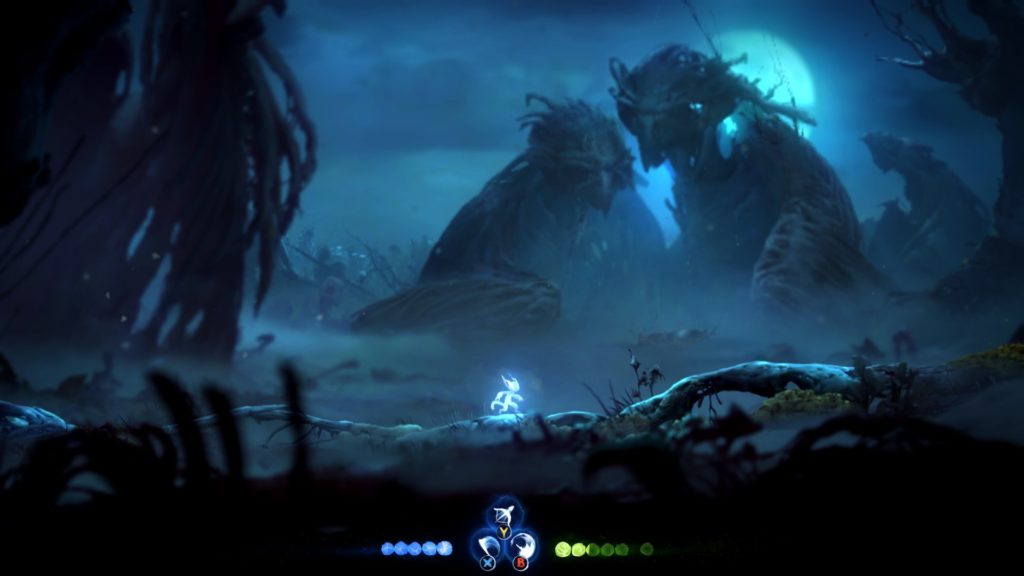- Genre: Action RPG
- Platform: PS5
- Also Available On: PS4, Xbox One, Xbox Series X, Stadia, Switch, PC
It’s pretty easy to look at this game and consider it a ripoff on Breath of the Wild, and frankly that isn’t necessarily the most wrong thing. It definitely shares a general metagame with BOTW, and it has the obvious gameplay hook of stamina while climbing. However, that’s taking an overly simple look at things. Immortals takes some steps in interesting directions that give it some unique legs – and quite frankly shows some good iteration on the general style beyond BOTW.
If there’s one way I’d really describe the overall metagame of Breath of the Wild it would be exploration supported by combat. Combat wasn’t the focus, and for the most part you could get through the game without fighting just about anything. The meat of that game was exploring to find shrines, and finishing the puzzles within. Immortals feels like a very different approach to me – combat supported by exploration. There’s definitely not a lack of puzzle dungeons, and the overall game flow is similar, but so much more of this game is based on combat, and that’s really the first bulk of differences from BOTW.
I suppose what’s important here is that their combat is really a lot of fun. There’s definitely a very Assassin’s Creed approach here, which isn’t that surprising. At its core you’ve got a similar approach of watching for enemy tells so you can parry or dodge attacks. There’s definite lessons learned here from their other series because the tells are extremely well done. Even with short timing, the enemy will have some obvious windup tick or some flash of particles or some full-body emissive effect to tell you that an attack is coming. For me it hit that nice line where the tells are fair, but still require good timing. Simply dodging or parrying is effective on its own, but nailing the timing gives you things like slow motion to get in some quick hits so there’s a certain level of benefit that makes being effective at these moves worthwhile.
There’s a secondary layer to combat that really worked out well in the integration of a stun system. This feels pulled right out of Final Fantasy 15, but the short version is that damaging an enemy enough can cause it to go into a stun state, opening up the enemy for some real big damage. Where this is really well integrated is that your best use of stuns is a slower attack axe, where the real damage potential is in a fast attack sword. This hugely encouraged me to be switching between the two weapons a lot, which really prevented combat from becoming boring. This also provided some interesting potential for larger group fights. Stunning a few enemies would allow me to then shift my attention elsewhere, rather than being overwhelmed by a bunch of enemies. In both group and larger solo fights, the system is extremely effective in a way that feels completely unique to this title, and really provides a direction for how improved combat mechanics could improve BOTW2.
Angry Birds (2020) pic.twitter.com/74LZneGFJl
— Dan Weiss (@schenksmill) December 29, 2020
That’s not to say that the game is all combat all the time. There’s definitely a lot of cool puzzle shrines here, and in a lot of cases they’re similarly silly and physics based like BOTW. However, there’s a lot more traversal mechanics at play that really give another sort of +1 to this iteration of the overall gameplay. BOTW had a lot of incidental secondary ways to solve shrines through clever or weird use of mechanics. Immortals feels a lot more direct. It’s got things like vertical and forward dashes to really push traversal. It’s got a magnetic-style ability that can push and pull objects around to set off weight plates. And ya, BOTW had some of this stuff, but Immortals separates itself out by having everything more easily accessible.
Immortals has everything on hotkeys. L1 plus a face button will activate one of these abilities, so they’re always there. You don’t have to switch between abilities in a slowing menu, which is a huge benefit for general speed of use. The other benefit is that all of these abilities use the shared stamina pool, rather than individual cooldowns, so they’re available all the time and can be chained back to back. The net result of this change is that puzzles are often less about doing a sequence of steps one at a time, and more often executing a fast series of steps rapidly. It’s an interesting dynamic shift from some of the more logic-based puzzles of BOTW and instead really reinforces the heavy physics-based puzzles that were some of my favorites.
When I did my ramblings for Breath of the Wild, it was pretty clear how special that game was. Even with four years gone, that’s still apparent. However, I think Immortals is at this point the better game. It clearly took the metagame and general physics fun of BOTW, but added in a lot of iterations in combat and ability use. Having the combat iteration in place added so much variety to what you’re doing, which is never a bad thing. Instead of going from spot to spot looking for a shrine ping, I was now going from spot to spot sometimes doing puzzles, but just as often fighting epic bosses and creatures of legend. It’s those kinds of changes that really push games forward, and in doing so it’s pretty clearly shown that there’s a lot of room for iteration in the sort of exploration-based open world ARPG subgenre.



